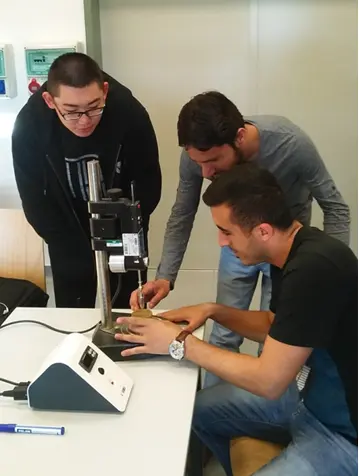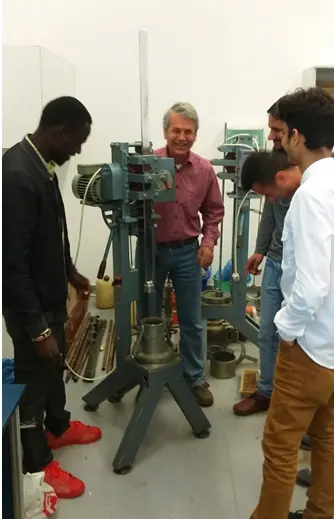Geodetic Engineering Laboratory
Competence of and equipment in the laboratory
The laboratory is used by students studying Geoinformatics I-II and GIS (Geographical Information System).
On the one hand we apply in our lab basic geodetic measuring techniques and computations using the following tools and devices: Trimble R6 GNSS Surveying System, Leica GNSS Surveying System, Leica Builder 509 Total Station, Leica TC400 Total Station, Leica TC600 Total Station, Leica D5 Laser Distance Meter with Digital Point Finder, Leica Disto Laser Distance Meter, Prexiso Laser Distance Meter, Leica Sprinter 105M Electronic Level, Leica Runner Automatic (optical) Level, Leica NA70 Automatic (optical) Level, Leica LNA10 Laser Level and several traditional theodolites.
Firstly, students start to acquire the principles of angle- and distance measurement by using analogue devices – theodolites, tapes, optical surveyor’s levels, then they apply their knowledge with state-of-the-art instruments and sophisticated technologies such as total stations, laser distance-meters, digital surveyors’ levels and GNSS receivers.
On the other hand there is also a Hungarian mapping solution with ITR 6 CAM software.
In the GIS practices we use an open-source application, called OpenJUMP. Students capture topographic and remote sensing data, collect and analyse geometric information, finally visualize results. The lab can accommodate 20 students at the same time.

Geotechnical Engineering Laboratory
Competence of the laboratory
 The laboratory provides an opportunity for students studying Geotechnics I (Soil Mechanics) and Geotechnics III (Foundation Engineering) to gain hands-on experience. The laboratory is equipped with the basic soil testing apparatus. Students perform investigations, design work individually or in teams. As part of the course work, students learn basic analytical laboratory skills, like preparing samples, scaling, or conducting basic laboratory tests. The laboratory is capable of accommodating about twenty students.
The laboratory provides an opportunity for students studying Geotechnics I (Soil Mechanics) and Geotechnics III (Foundation Engineering) to gain hands-on experience. The laboratory is equipped with the basic soil testing apparatus. Students perform investigations, design work individually or in teams. As part of the course work, students learn basic analytical laboratory skills, like preparing samples, scaling, or conducting basic laboratory tests. The laboratory is capable of accommodating about twenty students.
The test results with the related calculations are processed individually by the students. At the end of the semester students report all the conducted tests in a soil mechanics report. By using these test results they also prepare a soil mechanics recommendation for a given engineering project.
 Equipment in the laboratory
Equipment in the laboratory
● Hand-operated borehole drilling machine (BORRO),
● Different types of precision scales,
● Heating and drying ovens up to 600 °C,
● Sieves for grain-size distribution test,
● Hydrometer analysis,
● Atterberg Limits, Liquid limit devices, Casagrande apparatus, Cone penetrometer test, Plastic limit sets, Shrinkage limit sets,
● Constant-head permeability test,
● Falling-head permeability test,
● Proctor compaction test equipment and CBR,
● Dead-weight consolidation and compression machine,
● Direct shear box.
Materials Testing and Structural Engineering Laboratory
Competence of the laboratory
 In the Laboratory teaching of the following courses is provided: Construction Materials I, Construction Materials II, Material & Structural Engineering Laboratory.
In the Laboratory teaching of the following courses is provided: Construction Materials I, Construction Materials II, Material & Structural Engineering Laboratory.
We can perform a wide range of laboratory material tests related to construction materials, developing new building materials, etc. Research, which covers both theoretical and applied areas of research with respect to construction materials commonly used in the industry (concrete, mortar, concrete and special concrete technology, construction wood, glass, metal, plastic, etc.), is done in cooperation with students in the framework of the Scientific Student Research Work. The Faculty intends to create a professional laboratory which could be used in teaching and industry, as well. To become a professional laboratory, it needs to undergo an accreditation process for which preparations have already been made. After the laboratory accreditation comes to an end, it can be a significant materials testing laboratory in the region.
Concerning new research areas in Hungary investigations are intended on applying fibre-reinforced concrete, non-corrosive re-bars like FRP embedded in concrete structures, recycled concrete, testing structural glass, wooden structures, etc. The equipment is suitable with associated parts to study the flexural and compressive strength of hardened mortar, drilled rock samples, or carry out triaxial soil tests and asphalt testing, as well.
Equipment in the laboratory
The universal bending frame with load-bearing capacity of 300 kN is suitable for performing experiments with a scale in a ratio of one to one. With the help of the device, beams or ceilings with a span of 6 meters can be tested in bending.
The application possibilities of the universal tension/compression frame with a maximum load capacity of 500 kN are very wide. By means of this device, steel bars in tension can be tested from 4.2 mm up to 25 mm in diameter. During the tests the stress-strain diagram can be displayed on a computer due to the built-in elongation measuring apparatus. The equipment can be controlled in terms of deformation or applied force.
The concrete compression and tension frame with load-bearing capacity of 3000 kN and
100 kN. By means of this device, concrete cube in compressive strength and concrete beam in flexural strength can be tested. The device allows for testing high-strength concrete, as well.
RapidAir 457 system is an automated image-analysis system performing analysis of the air void distribution of hardened concrete. The RapidAir 457 system includes a PC control unit, a 20.1” color LCD monitor, a digital camera, a microscope objective mounted on a moving stage, and a user-friendly software designed to guide the user through the air void testing. The pixel resolution of the RapidAir system is around 2μm, field of view around 1.5x1.2mm and the magnification about 100x. The concrete samples to be analyzed using automatic analysis performed by RapidAir 457 are prepared using a surface contrast enhancement technique, where the final result is a black surface with white air voids. RapidAir 457 determines the volume of air (vol%), the specific surface, and the spacing factor.
The water permeability tester is used to determine the depth of penetration of water under pressure in the concrete specimens. The test is performed by clamping the specimen - cubic, cylindrical or prismatic - with a length of edge not less than 150 mm in diameter - between two flanges with special circular gaskets. The water, under controlled pressure, is then applied to the surface of the concrete specimen. After the testing period the penetration of water is measured by breaking the specimen. The quantity of penetrated water can also be measured through the graduated burettes fitted on top of the apparatus.
Durability is one of the most important properties of concrete. It depends on the type of building and the environmental conditions. The concrete freeze tester enables the freeze-thaw test. With this test procedure, the weathered quantity of a surface is measured by a number of freeze-thaw cycles. The test specimens are thereby placed in a solution of sodium chloride to stress the surface. The result gives an estimate for the resistance to freeze-thaw cycling for the concrete being tested.
The ultrasonic concrete tester is used for quality control and inspection of concrete. It measures the transit time of ultrasonic pulses through concrete for inspection of new and old structures, slabs, columns, walls, fire damaged areas, precast and pre-stressed beams, cylinders and other concrete forms.
The Schmidt Hammer is the most frequently used method worldwide for non-destructive testing of concrete and structural components. After the spring in the hammer is loaded, the test hammer will hit the concrete at the defined energy. The height of the rebounded mass is recorded and measured by the test equipment. With the help of the conversion diagram, the rebound value can be used to determine the corresponding compressive strength.
Water Resources Engineering Laboratory
Purpose and competence of the laboratory
Our Water Resources Engineering Laboratory includes three fields of education and research: hydraulics, hydrology and water quality. Our main goal is to understand and analyse the information necessary for e.g. to hydrologic forecasting, water resources problems and planning at different spatial scales (e.g. river basin, watershed, urban area, waterworks, water structures, etc.). Our basic principle is that integrated water management problems either in rural or urban environment mean the joint measurement and management of water quality and quantity.
In our lab course we learn how to collect and measure data - including field methods and analytical techniques - which we need to analyse in order to solve applied problems in hydrology. We have an open-channel flowmeter to measure the flow and discharge and also use a wide range of water-quality tests (nitrogen forms, metal, etc.) and water-quality meters (pH (power of hydrogen), conductivity, etc.).